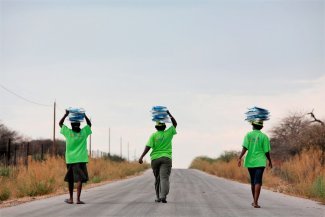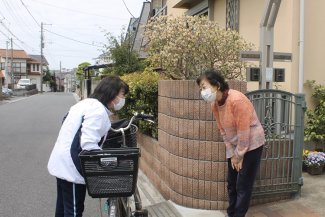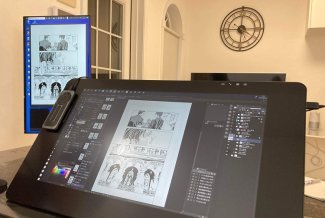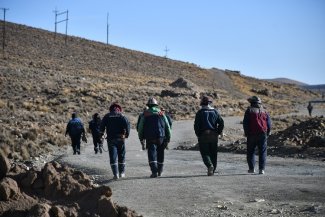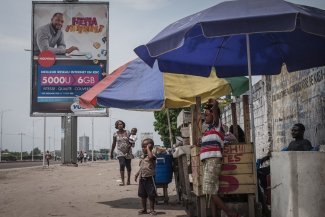Community health workers collect and share information from the local population in North Kivu, in the Democratic Republic of Congo, a region hit by the Ebola epidemic in January 2019. These trusted members of the local community, although not medical professionals, are proving to be vital players in the management of epidemics.
“The authorities have been very quick to take decisions during the Covid crisis,” says Siiri Ann Doka. Too quick, perhaps, for citizens and patients to be involved. Doka is in charge of monitoring health policies for Germany’s federal association of support groups bringing together people with disabilities and chronic illnesses (the Bundesarbeitsgemeinschaft Selbsthilfe in German). There are many such groups throughout Germany. As well as providing channels for mutual support, the idea is also to encourage participation in the health policy decisions of the people directly concerned.
The federal association has been around for over 50 years. Since 2004, it has also been sitting as a patient representative on the federal joint committee (Gemeinsamer Bundesausschuss) in charge of decisions concerning the health care system, such as the cost of care and how it is organised, the assessment of medication and treatments reimbursed by health insurance providers, etc. The right to vote is limited to the committee members representing doctors, health insurance providers and hospitals. The patient and health care user representatives only have a consultative role. “But we take part in the discussions, and we can table motions,” says Doka. “This allows us to draw attention to specific problems faced by patients,” such as difficult access to one or another type of medication. “Patient representatives also bring very specialised expertise to the table.”
Despite this expertise and their experience as participants in policy development, the decisions on how to respond to the crisis caused by the Covid-19 epidemic in Germany, as in other countries, were largely made without involving patient organisations. “In times of crisis, we tend to revert to old habits,” says Valéry Ridde, director of public health research at the IRD, France’s development research institute. After working in Quebec, then France, the researcher is currently based in Senegal.
“In France, the current crisis has seen clinicians at university hospitals taking back the reins of public health. It’s quite alarming,” he says.
Over the last 20 years or so, the French health system had also opened up to patient participation. It was even enshrined in national law in 2002 (the “Law concerning patients’ rights and the quality of the health system”), in the context of the fight against HIV and the strong involvement of patients and the communities affected by the epidemic. France’s ‘health democracy’ provides for the presence of health system user representatives, via associations, on most health bodies, from hospital boards to regional and national public health committees.
Since the onset of the Covid-19 pandemic, however, all this has been swept aside. Patient associations were neither included in the scientific council specially set up by the government nor consulted in any way. In September 2020, when the virus had been circulating in France for more than six months, the body grouping patients’ associations, France Assos Santé, once again insisted in an open letter to the French prime minister that its members were available to “work with the public authorities, health agencies and academic organisations at national, regional and local level”. To no avail. Even now, the government has still not responded to their offer.
The municipal authorities seem to be more willing to listen. The French city of Grenoble, for example, set up a citizens’ committee in November to consult local residents about the health crisis. The first discussion sessions underlined the need for a massive local testing campaign, before, during and after the Christmas holidays, and the inclusion of vulnerable people in the campaign. Another very different matter addressed was the issue of whether or not to keep food markets open, at a time when the rate of infections was on the rise.
North America: health services chosen by local communities based on local needs
Participatory responses to health care needs were developed in other parts of the world some decades ago. “Quebec introduced radical reforms to its health care system in 1971, with the establishment of a public health and social services network. The same reform also set up a new type of institution, the local community service centres, or CLSCs,” says Anne Plourde, a researcher at York University in Toronto and the Quebec Institute for Socio-Economic Research and Information. These neighbourhood centres provided both health and social services and, most importantly, were managed by the local community.
“Citizens were represented on the boards of all the establishments in the public network, but tended to be in a very small minority, except on the CLSCs, where they often formed a majority during the 1970s. The centres were often set up on the initiative of citizens themselves. They would submit a project to the government, which would then allocate them a budget. A provisional committee would then be set up to hire organisers who would consult the local people so that they could decide for themselves what kind of health and social services they wanted at the centre,” says the researcher and doctor in political science.
The CLSCs were able to offer services specific to the needs of the local population, such as prenatal care, the monitoring of young children, support for people with mental health or substance abuse problems and STD screening.
“The centres were also devoted to preventive care, in the broadest sense, such as campaigning for more green spaces in urban planning or dealing with local pollution issues.”
Similar experiments in community health were also developed in Latin America and the United States in the 1960s and 1970s, such as the neighborhood health clinics in the US. The participatory and democratic spirit of these centres in Quebec was, however, weakened by the gradual centralisation of the health system. “During the first ten years of their existence, these community centres were real vectors for citizen participation. Then, starting in the 1990s, the government began to merge the community service centres with other types of institutions, such as residences for the elderly. And the centralisation continued in the 2000s. Today, we are left with just 30 or so huge health care institutions for the whole of Quebec. There is no more democratic representation in the system,” says Plourde.
The authorities used economic rationale to justify the system’s recentralisation. “There were obvious financial justifications, economies of scale, and the fact that some management positions could be eliminated. The desire to make services more integrated and more coherent was also highlighted. But the research has been unanimous in noting the catastrophic repercussions of this centralisation, which goes much too far for the system to be functional.” And since the virus moves much faster than bureaucracy, the researcher adds: “This has caused major problems during the pandemic.”
In Africa, community health workers play a vital role
The development of frontline health care services based as close as possible to local communities is still very much present on the African continent. “It’s an approach that has long existed in French-speaking and West Africa, for example. Primary health care is provided at a very decentralised level, often with the mobilisation of local communities,” emphasises Ridde, whose work is currently focussed on Mali, Burkina Faso and Senegal.
Former healers, teachers or other trusted members of the community in villages and neighbourhoods are mobilised and trained to become community health workers. They work on a voluntary basis, or for a small fee. They are not health workers in the strictest sense, but the shortage of health professionals in Africa means the call for community health workers is growing. “International organisations and donors often lend support to community health worker programmes in villages, but it is very rarely lasting,” adds Ridde. And yet, not only in West Africa, but also in anglophone countries like South Africa, Kenya, Rwanda and Liberia, community workers are often vital links in the public health chain, particularly in the fight against epidemics, precisely thanks to the fact that they are in direct contact with the local community. They are trained to recognise symptoms, to provide information on treatment, and can also become channels for broadcasting prevention campaigns.
“Recent pandemics have resulted in community health care growing in strength and recognition,” says Anatole Manzi, a lecturer and director of clinical practice and quality improvement for the global organisation Partners In Health.
“The World Health Organization began promoting community health worker programmes when it saw that we were going to be short of medical and health staff in Africa. We need to think carefully about who else could help in the fight against diseases like HIV and malaria.”
The Ebola epidemics of recent years have also been decisive in the scaling up of these programmes. “Liberia, for example, is a relatively poor country and its investment in the health system is low, but the community health system has been strengthened by Ebola, because the country had no other choice. And when Covid-19 arrived, Liberia was in a position to react. It now has a network of community health workers who know the situation on the ground and know where resources would be best placed,” says Manzi.
The community health workers are able to report back on the epidemiological situation in a particular village or region of a country. But is this enough to ensure genuine citizen participation in public health policy? “There is a basic problem of lack of knowledge and training to begin with,” says Ridde. “Most of the people in positions of power and decision-making posts in the field of public health, be it in West Africa or France, are overwhelmingly doctors trained in epidemiological and statistical public health. Community and participatory approaches are not sufficiently taught and are often denigrated.”
In Rwanda, community health workers operating as male-female pairs, “report to the local health centre on the situation in their village, and from there the information goes to the district hospital and then from there to the Health Ministry,” explains Manzi. “I think this is the aspect that needs to be strengthened in many countries. If Health Ministry teams could listen more to the voices of community health workers, many things might change.”




